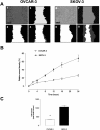Ovarian cancer cell invasiveness is associated with discordant exosomal sequestration of Let-7 miRNA and miR-200
- PMID: 24393345
- PMCID: PMC3896684
- DOI: 10.1186/1479-5876-12-4
Ovarian cancer cell invasiveness is associated with discordant exosomal sequestration of Let-7 miRNA and miR-200
Abstract
Background: The role of exosomes in the pathogenesis and metastatic spread of cancer remains to be fully elucidated. Recent studies support the hypothesis that the release of exosomes from cells modifies local extracellular conditions to promote cell growth and neovascularisation. In addition, exosomes may modify the phenotype of parent and/or target cell. For example, sequestration of signaling mediators into exosomes may reduce their intracellular bioavailability to the parent cell thereby altering cell phenotype and metastatic potential. The fusion of released exosomes with target cell and delivery may also modify cell function and activity. In this study, to further elucidate the role of exosomes in ovarian cancer, the release of exosomes from two ovarian cancer cell lines of different invasive capacity and their miRNA content of exosomes were compared. The hypothesis to be tested was that ovarian cancer cell invasiveness is associated with altered release of exosomes and discordant exosomal sequestration of miRNA.
Methods: High (SKOV-3) and low (OVCAR-3) invasive ovarian cancer cell lines were used to characterize their exosome release. SKOV-3 and OVCAR-3 cells were cultured (DMEM, 20% exosome-free FBS) under an atmosphere of 8% O2 for 24 hours. Cell-conditioned media were collected and exosomes were isolated by differential and buoyant density centrifugation and characterised by Western blot (CD63 and CD9). Exosomal microRNA (let-7a-f and miR-200a-c) content was established by real-time PCR.
Results: Exosomes were identified with by the presence of typical cup-shaped spherical vesicle and the expression of exosome markers: CD63, CD9. SKOV-3 cells released 2.7-fold more exosomes (1.22 ± 0.11 μg/106 cells) compared to OVCAR-3 (0.44 ± 0.05 μg/106 cells). The let-7 family miRNA transcripts were identified in both ovarian cancer cell lines and their exosomes. The let-7 family transcripts were more abundant in OVCAR-3 cell than SKOV-3 cells. In contrast, let-7 family transcripts were more abundant in exosomes from SKOV-3 than OVCAR-3. miR-200 family transcripts were only identified in OVCAR-3 cells and their exosomes.
Conclusions: The data obtained in this study are consistent with the hypothesis that the releases of exosomes varies significantly between ovarian cancer cell lines and correlates with their invasive potential.
Figures






Similar articles
-
Exosomal miR-99a-5p is elevated in sera of ovarian cancer patients and promotes cancer cell invasion by increasing fibronectin and vitronectin expression in neighboring peritoneal mesothelial cells.BMC Cancer. 2018 Nov 5;18(1):1065. doi: 10.1186/s12885-018-4974-5. BMC Cancer. 2018. PMID: 30396333 Free PMC article.
-
Adipocyte derived exosomes promote cell invasion and challenge paclitaxel efficacy in ovarian cancer.Cell Commun Signal. 2024 Sep 16;22(1):443. doi: 10.1186/s12964-024-01806-4. Cell Commun Signal. 2024. PMID: 39285292 Free PMC article.
-
[Screening and identification of potential miRNA involved in ovarian cancer invasion and metastasis].Zhonghua Zhong Liu Za Zhi. 2010 Sep;32(9):650-4. Zhonghua Zhong Liu Za Zhi. 2010. PMID: 21122376 Chinese.
-
The microRNA Let-7 and its exosomal form: Epigenetic regulators of gynecological cancers.Cell Biol Toxicol. 2024 Jun 5;40(1):42. doi: 10.1007/s10565-024-09884-3. Cell Biol Toxicol. 2024. PMID: 38836981 Free PMC article. Review.
-
Exosomes as divine messengers: are they the Hermes of modern molecular oncology?Cell Death Differ. 2015 Jan;22(1):34-45. doi: 10.1038/cdd.2014.130. Epub 2014 Sep 19. Cell Death Differ. 2015. PMID: 25236394 Free PMC article. Review.
Cited by
-
High-Throughput and Automated Acoustic Trapping of Extracellular Vesicles to Identify microRNAs With Diagnostic Potential for Prostate Cancer.Front Oncol. 2021 Mar 25;11:631021. doi: 10.3389/fonc.2021.631021. eCollection 2021. Front Oncol. 2021. PMID: 33842337 Free PMC article.
-
Expression of serum let-7c, let-7i, and let-7f microRNA with its target gene, pepsinogen C, in gastric cancer and precancerous disease.Tumour Biol. 2015 May;36(5):3337-43. doi: 10.1007/s13277-014-2967-9. Epub 2014 Dec 31. Tumour Biol. 2015. PMID: 25549793
-
MicroRNA‑mediated approaches in ovarian cancer therapy: A comprehensive systematic review.Oncol Lett. 2024 Aug 12;28(4):491. doi: 10.3892/ol.2024.14624. eCollection 2024 Oct. Oncol Lett. 2024. PMID: 39185494 Free PMC article.
-
Intercellular Vesicular Transfer by Exosomes, Microparticles and Oncosomes - Implications for Cancer Biology and Treatments.Front Oncol. 2019 Mar 6;9:125. doi: 10.3389/fonc.2019.00125. eCollection 2019. Front Oncol. 2019. PMID: 30895170 Free PMC article. Review.
-
Circulating Exosomal miRNAs as Biomarkers in Epithelial Ovarian Cancer.Biomedicines. 2021 Oct 10;9(10):1433. doi: 10.3390/biomedicines9101433. Biomedicines. 2021. PMID: 34680550 Free PMC article. Review.
References
Publication types
MeSH terms
Substances
LinkOut - more resources
Full Text Sources
Other Literature Sources
Medical
Miscellaneous

